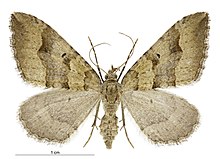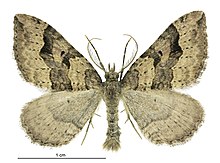| New Zealand looper | |
|---|---|

| |
| Female | |

| |
| Male | |
| Scientific classification | |
| Domain: | Eukaryota |
| Kingdom: | Animalia |
| Phylum: | Arthropoda |
| Class: | Insecta |
| Order: | Lepidoptera |
| Family: | Geometridae |
| Genus: | Epyaxa |
| Species: | E. rosearia |
| Binomial name | |
| Epyaxa rosearia (Doubleday, 1843) | |
| Synonyms | |
| |
Epyaxa rosearia, the New Zealand looper or plantain moth, is a moth of the family Geometridae. It is endemic to New Zealand.
Taxonomy
E. rosearia was first described by Edward Doubleday in 1843 and named Cidaria rosearia.
Description
The eggs of this species are pale yellow and oval with a smooth shell.
Alex Purdie describes the caterpillar of this species as:
Length, at rest, about three- quarters of an inch. Colour light-green, with indistinct whitish longitudinal lines, and a narrow median dorsal stripe of the ground colour, edged on each side by one of these whitish lines; a subdorsal whitish line on each side of the median stripe; the ground colour shows again as a lateral line, edged below with whitish. Under-side with delicate whitish or yellowish longitudinal tracings, as on the upper side. The junctions of the segments show yellowish or whitish rings when the larva contracts. Head, greenish-yellow. Body tapering somewhat to the head.
The caterpillars form a chrysalis that is glossy and very dark brownish black. They can be found amongst the leaves of the forest floor. E. rosearia adults are varied in appearance. They can have a pinkish tinge or can be brownish in hue although olive green is also common.
Distribution
E. rosearia are very common throughout New Zealand.
Host species
While it is endemic to New Zealand, the larvae have so far only been recorded feeding on exotic plant species: Nasturtium officinale, Plantago lanceolata, Trifolium ambiguum, Trifolium repens and Tropaeolum majus. The larvae also seem to feed on the leaves of Trifolium caucasicum.
Interaction with humans
A recent study suggests this moth may be assisting with the pollination of avocado trees.
References
- ^ Dugdale , J. S. (23 September 1988). "Lepidoptera - annotated catalogue, and keys to family-group taxa". Fauna of New Zealand. 14. Department of Scientific and Industrial Research: 180. doi:10.7931/J2/FNZ.14. ISSN 0111-5383. Wikidata Q45083134.
- Edlin, Bob (20 April 2014). "North Island farmers report bumper summer for native plantain moth". AgScience. New Zealand Institute of Agricultural and Horticultural Science. Retrieved 14 May 2019.
- "Plantain moth". AgPest. AgResearch. Retrieved 14 May 2019.
- "Cidaria rosearia Doubleday, 1843". New Zealand Organisms Register. Landcare Research New Zealand Ltd. Retrieved 15 January 2018.
- Dieffenbach, E. (1843). "List of Annulose Animals hitherto recorded as found in New Zealand with descriptions of some new species by Messrs. Adam White and Edward Doubleday". Travels in New Zealand: With Contributions to the Geography, Geology, Botany and Natural History of the Country. Vol. 2. London: John Murray. p. 285.
- ^ Purdie, A. (1885). "Life History of Epyaxa rosearia, Dbld". Transactions and Proceedings of the New Zealand Institute. 18: 208–209 – via Biodiversity Heritage Library.
- ^ Hoare, Robert J. B. (2014). A Photographic Guide to Moths & Butterflies of New Zealand. Ball, Olivier. Auckland: New Holland Publishers (NZ) Ltd. p. 95. ISBN 9781869663995. OCLC 891672034.
- "Epyaxa rosearia (Doubleday, 1843)". New Zealand Organisms Register. Landcare Research New Zealand Ltd. Retrieved 14 January 2018.
- "PlantSynz - Invertebrate herbivore biodiversity assessment tool: Database". Plant-SyNZ. Landcare Research New Zealand Ltd. 2011. Retrieved 14 January 2018.
- Max N. Buxton; Robert J. B. Hoare; Melissa A. Broussard; Theo Van Noort; Grant R. T. Fale; Tamatea Nathan; David E. Pattemore (25 August 2021), Moths as potential pollinators in avocado (Persea americana) orchards in temperate regions, pp. 1–12, doi:10.1080/01140671.2021.1966480, Wikidata Q108352633
| Taxon identifiers | |
|---|---|
| Epyaxa rosearia | |
This Xanthorhoini moth related article is a stub. You can help Misplaced Pages by expanding it. |